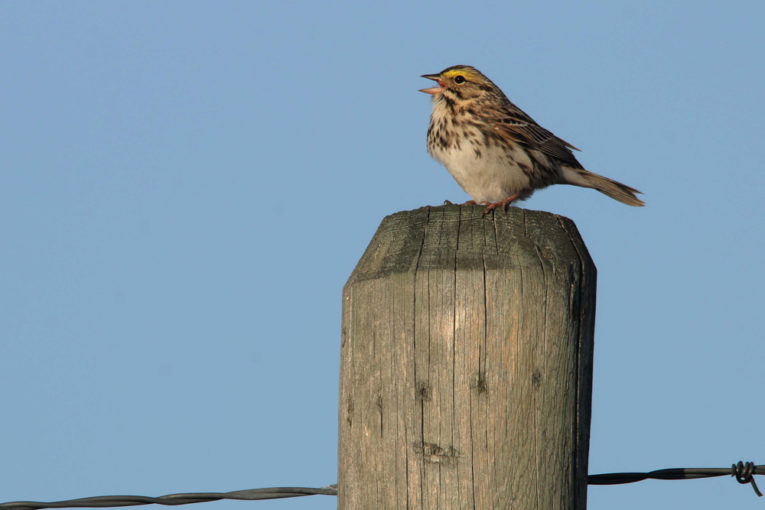
Noisy oilpatch equipment is causing songbirds to change their tune, concludes research from the University of Manitoba.
“It’s something that is really picking up, the idea of noise pollution,” said Miya Warrington, a co-author of a new paper in Condor, the journal of the American Ornithological Society. “We want to see what is that doing for the birds.”
Warrington looked at savannah sparrows, a small, common, thick-beaked sparrow with a splash of yellow over the eye. Its complex song has up to nine different “syllables” that convey a lot of information.
Some parts of the song deliver a territorial warning. Others advertise for mates. Others just say, “I am here.” All are crucial messages for the sparrow’s survival. Each bird has an individual version of the song, which includes elements from a high-pitched trill to an insect-like buzz.
These days, however, sparrows share the prairies with a lot of noisy machinery. Oil and gas infrastructure is common on the plains and Warrington wanted to see how birdsong competes with it.
“You can hear birds clearly when it’s quieter,” she said. “When you’re closer to the infrastructure, you don’t hear the birds as clearly.
“You start to think, if I can’t hear, maybe the birds can’t hear.”
She looked at 26 sites around Brooks in southern Alberta. The sites contained four types of energy infrastructure: natural gas compressors, pumpjacks, screw pumps powered by the electrical grid and screw pumps powered by generators.
She recorded and analyzed the songs of 73 male sparrows between the months of May and July and compared them with the songs of sparrows where there were no oilpatch facilities.
The analysis showed that all pumps and compressors made sounds on the same frequencies as at least part of the sparrow’s song. Recordings revealed the birds were adjusting parts of their songs, depending on the source of the background noise.
“All syllable types were significantly affected by at least one infrastructure type,” the paper says.
In some cases, sparrows sang the entire song at higher frequencies, as if they’d transposed it to a higher key.
Of the four types of infrastructure, generator-powered screw pumps had the most impact while natural gas compressors had the least.
Warrington suggests the birds made changes in efforts to be heard over the sound of the equipment.
“The birds are modifying their birdsong in response to the noise that’s created by this oil and natural gas infrastructure.”
Avian response to human noise is a hot topic in the bird research world.
Another paper in the same issue of Condor looks at how grouse adjust their mating calls in the presence of sound from wind turbines. Urban birds have also been shown to raise the pitch of their songs in noisy city environments.
The issue is particularly pressing for grassland birds such as sparrows. While almost all songbirds are in decline, grassland species are declining the quickest.
“They’ve actually been looking at a whole lot of grassland species and finding that, in some species, the presence of oil infrastructure is affecting reproduction while in others it’s not.”
Nobody yet knows if the sparrows’ new songs are conveying the same old messages.
“Is it changing how those who are listening can respond? Are these modifications helping them get their message across?” Warrington asks.
“We want to see what is that doing for the birds.”
You can read more of the news on source
